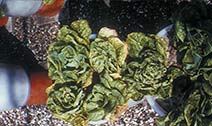Boron deficiency in lettuce

Boron deficiency in lettuce causes:
- Reduction in growth
- Malformation of the young leaves
- Development of dark spots, usually near the leaf tip, which later develop into a marginal necrosis
The leaves are thick, brittle, and frequently cupped. Head development is poor and chlorosis also occurs. The yellow heads become rotten in the center following the death of the growing point. Roots on boron deficient plants are brown, short, and knotted in appearance.
Tip burn on younger leaves has been associated with boron deficiency but this symptom is likely due to other factors. The early stages of boron deficiency can be confused with tip burn which, unlike boron deficiency, does not lead to lack of “hearting” and death of growing point.
Typical recommended ranges for boron boradcast soil application for lettuce is 1-2 lbs of B/acre. Normal plant analysis levels for the best quality and marketability have leaf boron levels in the 25-50 ppm range.*
*Always consult local crop advisors to check the proper dose rates. Rates of boron fertilization should be based on yield goals along with soil tests and/or plant tissue analyses.